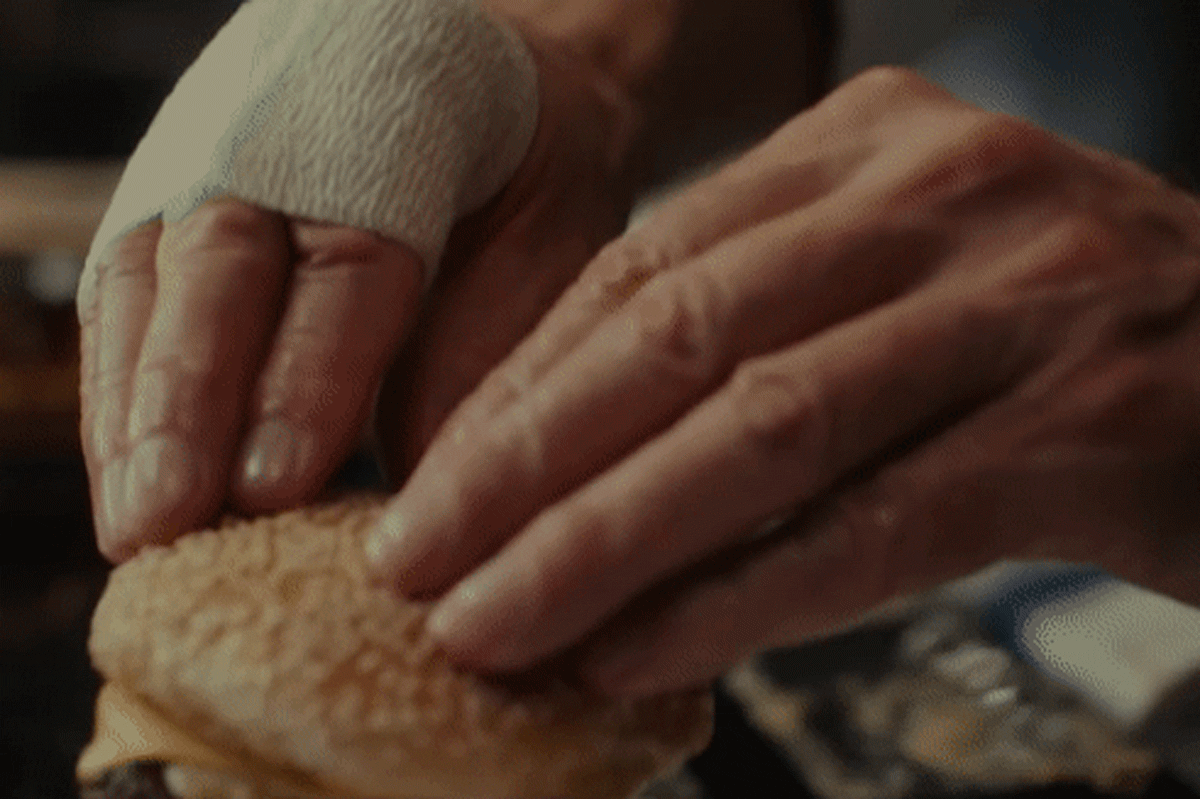In between two darkly thoughtful courses that chef Andrew Slowik (Ralph Fiennes) has designed in The Menu, he asks one of his mega-rich regulars if he can remember any of what he’s eaten at Hawthorn in his 11 visits. In the movie, Hawthorn is an intensely sought-after fine-dining reservation that most people could not afford once, much less the 11 times the man has attended. The man can’t remember a single course.
I’d wager decent money that neither can anyone who’s seen The Menu. Does anyone remember the sauces that came with no bread? Or what kind of tea that was? Except I’d bet the same money you remember the burger. That burger. The burger that saves the day.
I don’t think food has ever saved my life, but a cheeseburger does exactly that in The Menu. When Margot (Anya Taylor-Joy) orders one from Slowik as a last-ditch effort to survive the night and the meal, the tone of the film shifts. As the music soars, seemingly conducted by the sizzling meat, Slowik lightens, and the tension in the dining room dims. As the meat cooks, the film glides into slow motion to take in the application of onions and cheese and the flowing juices. It’s beautiful. This must be a perfect burger.
“It’s pure magic and 100 percent pure science,” said George Motz, a food historian and the author of several books on burger history, as well as the host of Burger Scholar Sessions for First We Feast. The history of the smash burger is, in fact, a bit of American history worthy of the finesse and love it gets in the film. According to Motz, the movie’s smash-style burger “is the burger that started it all”—“the original American burger.” Around the turn of the 20th century, smash burgers were made for factory workers and fairgoers. Without refrigeration, these small balls of meat pushed hard into a hot pan were a quick cook to feed the masses, but they were considered too lowly for mass appeal. It was a fringe American food invention. Then, in 1921, the smash burger began to climb from socially disreputable status to becoming as American as apple pie. White Castle, the first American burger chain, was established. “They were the first to standardize the bun and the cooking. They were the first real fast-food hamburger,” Motz said.
Various iterations of the burger have had the spotlight over the years, but the smash burger has been ascendant lately, thanks in part to exploding chains like Shake Shack. Numerous articles in places like Eater are dedicated to mapping them in cities from New York to Chicago and L.A. Since about 2018, tastes have been shifting away from the thick patty on (for God’s sake) brioche or (shoot me) a pretzel bun. Maybe it’s because of the sky-high prices, or because we aren’t genetically made to unhinge our jaws like snakes, or because thin patties cook much quicker and taste better. Motz has his own theories: “It’s faster, it’s better, and it’s authentic, and I think people like that about it,” he said. “People consider it to be a trend, but people don’t realize it’s existed before. We’re going back in time, not creating something new.”
Whatever the reason, more independent restaurants are opening around the country that are going back to a thin patty, pushed hard into a hot pan. The Menu’s burger is so memorable partly because, at the moment, it’s the burger.
The movie’s version was built by chef John Benhase, who owns own restaurants in Savannah, Georgia, and served as a culinary consultant on The Menu. In his days working at a Jewish delicatessen, “we went through a lot of different variations” of burgers, he told me. “At one point, we were grinding sesame seeds fresh into mayonnaise. We were completely insane.” But for this burger, he knew exactly what was needed. “Bread, butter, pickles, super white-trash sauce, cheese. It’s very technique-driven, very precise in why it works and why it’s good.” Five ingredients cooked very specifically to heighten each of them. Alchemy in a bite.
In my neighborhood, there’s a place that I think Motz and Benhase would appreciate called Bernie’s, which New York Magazine last year declared “like Applebee’s, but good” and which checks a lot of the boxes of American food history. Thin-patty burgers, mozz sticks, pork ribs, and shrimp cocktail are all prominent on just about every table, foods many Americans know better than their extended family, done right with earnest appreciation. Unsurprisingly, the restaurant has a line out the door 20 minutes before opening every night. You can find me there waiting with everyone else.
What makes this style of burger so en vogue right now is complex. Or maybe it’s not at all. The timeless simplicity, and Margot’s order, wins over even an unhinged fine-dining chef who has turned to murdering bankers and food critics. It’s the food that matters the most in The Menu and the burger that matters the most in America right now. As Slowik says to Margot, a smash burger will “make you feel as though you’re eating the first cheeseburger you ever ate.” Sounds perfect to me.
